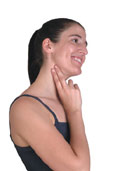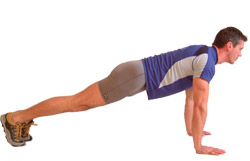The Fitness Tests
The second part of the fitness test will help you to assess your current level of fitness, your health and strength.
This will help in designing an appropriate exercise program designed for your fitness and also give you a benchmark against which you can test your progress.
It’s not necessary to do all the tests to get a measure of fitness – if you are a complete beginner, some of the tests may prove quite difficult.
It’s best to have someone else help you with the tests, preferably an exercise professional.
Its important that you try and keep the tests the same throughout, i.e. using the same style of sit-ups etc. And very important that you make a written note of your progress.
If you feel light headed / dizzy at any point, then stop the test and look at seeing your doctor if you still feel unwell after 5 minutes.
For any of the strength or aerobic tests, aim to fully warm-up and stretch to prevent injury.
|
|
|
|
The best time to take this is when you first wake up in the morning. If you take the recordings over three days and average them, you will get a more accurate result. |
|
 |
|
|
|
|
 |
|
|
|
|
|
Having your blood pressure taken is a very easy operation, best done by someone with experience. There are electrical systems available, but be sure they are accurate before relying on them. |
 |
|
|
|
|
This measures the size of your lungs. Most doctors and good health clubs should be able to offer this service. |
 |
|
|
|
|
The static water tank is the most accurate method, but is also expensive. More common methods include a bio-impedance machine or body calipers. |
|
|
|
|
|
Poor flexibility is a result of tight muscles, and can lead to injury. |
|
|
|
|
|
Press-ups are an excellent way of judging a person’s upper body strength. |
|
|
|
|
|
Lie flat on the floor with knees bent, hands to the side of your head, raise up till your elbows touch your knees, lower then repeat. |
|
|
|
|
|
This test is simple – with your back pressed into the wall, and your legs bent at 90 degrees, see how long you can maintain this position. |
 |
|
|
||
|
From a squatting position, jump up as high as possible, holding a piece of chalk in one hand. |
 |
|
|
|
|
|
From a standing start, have a partner blow a whistle, and three seconds later blow again. The goal is to run as fast as you can over a flat surface in that time. |
|
|
|
|
|
Accurately measure how far you can run in twelve minutes. This is best done on a running track or treadmill. |
|
|
|
|
|
On a flat surface draw a total of 12 circles, 1 inch larger than your shoe size. They need to be one meter apart, running at right angles to each other in a zig-zag line. |
|
Becoming a Netfit member is a good way to help you improve, and stay motivated.
Once you have your results, you have a benchmark to work from. Analyze each area of the fitness test, and target those you are weak on.
Printing off the RECORD CHART will help you keep a record of your results. Enjoy the tests!







